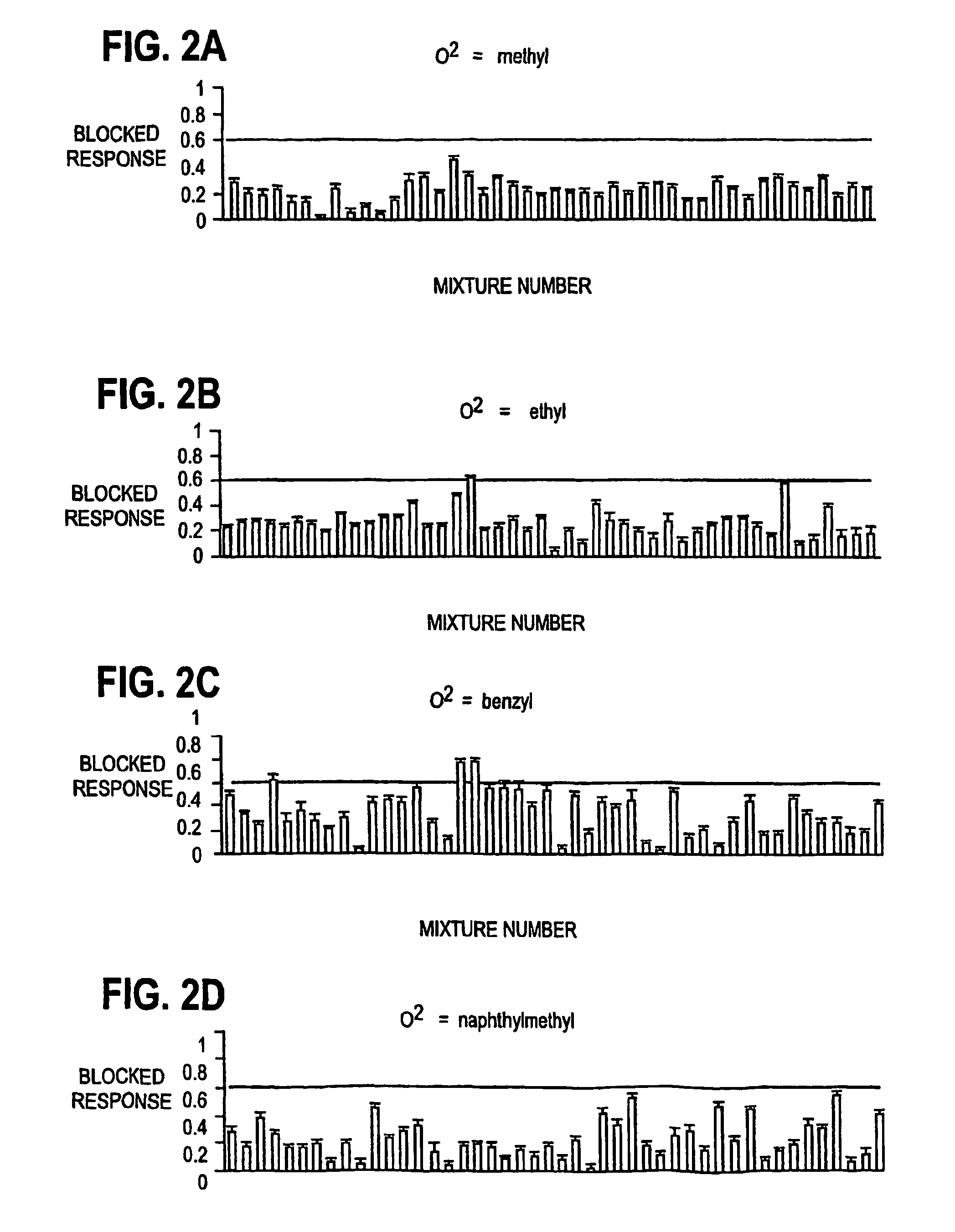NMDA receptor channel blocker with neuroprotective activity
- Summary
- Abstract
- Description
- Claims
- Application Information
AI Technical Summary
Benefits of technology
Problems solved by technology
Method used
Image
Examples
example i
Synthesis of the Library and Individual N-Alkylated Triamines
[0044]The N-alkylated triamine mixtures and individual compounds were synthesized on the solid phase using the “tea-bag” methodology (Houghten R. A., Proc. Natl. Acad. Sci. USA, 82:5131–5135, 1985) by selective alkylation and exhaustive reduction as described elsewhere (Dorner B., et al., Bioorg. Medicinal Chem., 4:709–715, 1996; Ostresh J. M., et al., J. Org. Chem., 63:8622–8623, 1998; Nefzi A., et al., Tetrahedron, 55:335–344, 1999). The mixtures were prepared using the divide, couple and recombine method (Houghten R. A., et al., Nature, 354(6348):84–6, 1991; Dorner B., et al., Bioorg. Medicinal Chem., 4:709–715, 1996). In brief, the first amino acid was coupled using conventional Fmoc chemistry, and following removal of the Fmoc group, the N-terminal amino group was tritylated by reaction with a solution of trityl chloride (5 molar excess over the total free N-α-amino groups) for 3 hours at room temperature. N-alkylatio...
example ii
Expression of NMDA Receptors in Xenopus Oocytes
[0046]Recombinant NMDA receptor subunits, NR1 (Planells-Cases R, et al., Proc. Natl. Acad. Sci. USA, 90(11):5057–61, 1993) and NR2A (Le Bourdelles B, et al., J. Neurochem., 62(6):2091–8, 1994) was used for screening the dipeptidomimetic combinatorial library. cDNAs of NR1 and NR2A were linearized with NOT1. cRNAs encoding NR1 and NR2A were synthesized from the linearized cDNAs templates according to manufacturer specifications (Ambion). NR1 mutant (N616Q) was used to examine the site of action of the identified lead. The NR1A mutants were linearized with NOT1 and use of T7 for sense. cDNA of human glutamate receptor / GluR1 (Sun W., et al., Proc. Natl. Acad. Sci. USA, 89:1443–1447, 1992) was linearized with Hind III and the use of T3 promoter for the synthesis of its cDNA. cDNAs were quantified by spectroscopy and the quality were assessed by gel electrophoresis.
[0047]Oocytes of stage V and VI were surgically removed from the ovaries of X...
example iii
Electrophysiology of the NMDA Receptor
[0049]On days two to six following injection of cRNAs, whole oocyte currents were recorded with standard two-electrode voltage-clamp. All electrophysiological studies, unless otherwise stated, were performed in Ba2+ / flufenamic-Ringer's solution (in mM: 10 HEPES pH7.5, 115 NaCl, 2.8 KCl, 2.0 BaCl2, 0.1 flufenamic, 0.1 niflumic acid) at ambient temperature as previously described (Ostresh J. M., et al., J. Org. Chem., 63:8622–8623, 1998; Nefzi A., et al., Tetrahedron, 55:335–344, 1999). Both current and voltage electrodes were filled with 3M KCl and have a tested resistance of 0.5–1 MOhm. The blocking activities of the library were assessed at 10 μM (assuming the molecular weight is ˜500). The screening of the subsequent twenty one compounds synthesized based on the primary screening were performed at 1 μM. Inward currents were elicited from a holding potential of −80 mV except where indicated. NMDA receptors were activated by abruptly exposing oo...
PUM
| Property | Measurement | Unit |
|---|---|---|
| Selectivity | aaaaa | aaaaa |
| Degradation properties | aaaaa | aaaaa |
Abstract
Description
Claims
Application Information
 Login to View More
Login to View More - R&D
- Intellectual Property
- Life Sciences
- Materials
- Tech Scout
- Unparalleled Data Quality
- Higher Quality Content
- 60% Fewer Hallucinations
Browse by: Latest US Patents, China's latest patents, Technical Efficacy Thesaurus, Application Domain, Technology Topic, Popular Technical Reports.
© 2025 PatSnap. All rights reserved.Legal|Privacy policy|Modern Slavery Act Transparency Statement|Sitemap|About US| Contact US: help@patsnap.com



